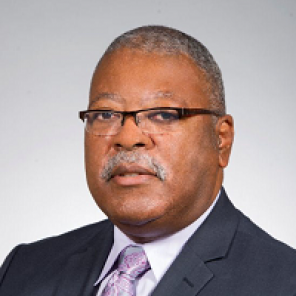
Reginald W. Taylor is currently Associate Professor and Director of Pre-doctoral Orthodontics at the Texas A&M (Baylor) College of Dentistry, Dallas. Taylor is originally from New Orleans, La. and received his B.S. in Chemistry from Xavier University, Louisiana. He then received his D.M.D. and D.M.Sc. in Oral Biology from the Harvard School of Dental Medicine and the Forsyth Dental Center, Cambridge, Mass. After receiving his degree and certificate, he accepted a full-time faculty position at the University of Alabama School of Dentistry, Birmingham, where he taught pre and post-doctoral orthodontics until accepting his current position in 2000.
Taylor is currently a mid-career academician in the department of Orthodontics. As a holder of both Board Certification in Orthodontics and a D.M.Sc. in Oral Biology, he is in a unique position to see the potential applicability of “bench top” research to clinical practice. Taylor has published original articles as well as given oral presentations in both clinical and basic science research areas. In his role as Director of Pre-doctoral Orthodontics, he has been able to convey both innovations in clinical practice and research to the next generations of dentists.
Taylor’ research focuses on the organization and development of the extracellular matrix of craniofacial structures, specifically, the periodontal ligament. He hopes to gain additional insight into the biological processes that when activated by a sustained force applied to a tooth results in orthodontic tooth movement and also hopes to determine if there are different mechanisms related to the magnitude of the applied force, and if so, begin to tease out these magnitude-determined differences. This will ultimately help orthodontists utilize the most biologically efficient force systems for orthodontic tooth movement.
1. How did you first learn about the AADR and what motivated you to join?
I first learned about the AADR as an orthodontic resident/graduate student through dental school faculty. At that time the AADR was the vehicle for disseminating the results of your dental-related basic science research. The annual meetings were also a place where you could meet people, exchange ideas and sometimes develop collaborations. This is what encouraged me to not only join, but to remain a member for 30 years.
2. Can you describe your research? How do you hope your work will impact others?
Most of my research involves extracellular matrix (ECM) of bone and ligament, primarily periodontal ligament. I am particularly interested in the organization and control of ECM arrangement. It is my hope that a better understanding of these processes will help us better understand how to optimize orthodontic tooth movement while decreasing the adverse sequelae that are sometimes associated with tooth movement.
3. Can you describe your experience being a researcher from an underrepresented group in science?
To be perfectly honest early in my career, I found it to be unsettling to be the only one or one of two or three members of an underrepresented in a session. This, I must say, was not particular to the AADR. I am not the most outgoing personality-wise, so this would on occasion lead to feelings of isolation among thousands of people. Fortunately, things are changing for the better. Also, this encouraged me to reach out to younger members to encourage them and help them along, if not through my successes, through my mistakes.
4. Have you had the opportunity to mentor underrepresented minorities or work to increase diversity in science? If yes, can you describe your experience and what agencies/organizations you worked with?
Fortunately, I have had the opportunity to mentor Underrepresented Minorities and work to increase diversity in science. My work as a member of the AADR Committee on Diversity and Inclusion has definitely allowed me to help develop mechanisms to increase the number of Underrepresented Minorities in dental research. As a clinician scientist, I have also had the opportunity to reach out to, encourage and mentor students at all levels in pursuing research projects. Although many of them have gone on to clinical careers, I think that their research experience helped shape how they view and utilize evidence in their clinical practices.
5. Based on your experience, how would you encourage AADR members to help increase the diversity of the research workforce?
I would encourage the AADR members to be intentional about achieving this goal. There are too many impediments for it to happen spontaneously. It is like building a house. Putting lumber on a piece of land will not result in a house. You need to have a plan. You will then need a lot of dedicated people to work consistently on the plan. There will be many pieces, and you will need people who are skilled in specific areas working both together and in the proper sequence. There will need to be adjustments along the way to deal with unanticipated problems. Once the “house” is built, then you will still need those who are responsible for maintenance and upkeep. It will be a long and arduous process, but each level of accomplishment will bring some satisfaction, ultimately resulting in fruition.
6. What role do you think professional associations can play in supporting its members who are members of underrepresented minority/ethnic groups?
Professional associations should be the hub of support for its members. This is equally, if not more, true for Underrepresented Minorities members. Success is about information and collaboration. The professional associations should serve as a clearinghouse of information regarding current research, funding and jobs. They should also provide a space where people of diverse backgrounds with similar scientific/academic interests can meet, associate and form lasting collaborations.




